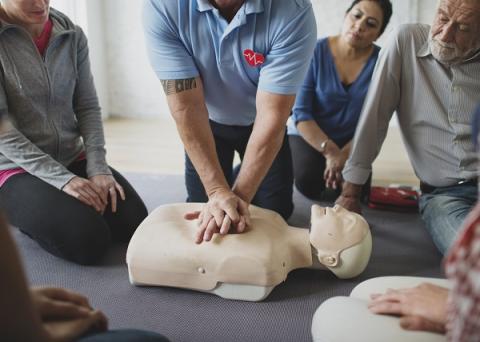CPR – These Simple Steps Can Save a Life
CPR stands for cardiopulmonary resuscitation. As it applies to those of us who are not trained health care providers or first responders, CPR includes just two lifesaving steps. It is sometimes referred to as “hands-only CPR,” “bystander CPR,” or “CPR first aid.”
In the past, first aid CPR was called “mouth-to-mouth resuscitation” and involved a combination of breathing air into the person’s mouth and doing chest compressions. Today, chest compressions combined with breathing assistance is still included in the CPR training of health care professionals. But for the rest of us, the approved technique now uses only chest compressions performed continuously at the rate of 100 to 120 compressions per minute. CPR as a form of first aid can save a life by maintaining blood flow to the person’s brain and other vital organs until professional medical help arrives.
Hand-only CPR includes two essential steps that must occur as quickly as possible:
- First, call or have someone else call 911; ask for emergency help, which the operator will know includes first responders with AED. (AED stands for automated external defibrillator.)
- Second, start chest compressions at an uninterrupted cadence of 100 to 120 compressions until help arrives.
Doesn’t sound complicated, and it’s not. But don’t be fooled. There’s a right way and many wrong ways of giving chest compressions. And just being familiar with the concept and gist of bystander CPR usually isn’t enough to prepare a person to know exactly what to do in a medical emergency and start doing it instantly and reflexively. For that, a person needs more basic training and, if possible, hands-on practice with a qualified CPR trainer. We recommend two steps to building your CPR know-how and comfort level.
Step one is to become more familiar with hand-only CPR by watching a few of the many short videos available online. Some great options for this basic orientation are at the American Heart Association’s Hands-Only CPR page, or the association’s Nation of Lifesavers page. Or, for another great introduction, download and print its CPR Guide Infographic. If you are able to, plan to invest at least an hour of your time with these and other reputable online sources learning as much as you can about CPR as first aid.
Step two will require a bit more of your time, but still less than you might expect. Step two is finding, signing up for, and participating in a training session in your community or through an online learning course. Courses are often available free or at low cost and at many convenient times and places. An online course can fill your need, but having an in-person trainer affords the added advantage of training, usually on a dummy, in front of an expert who can help you practice and become completely comfortable with giving those all-important chest compressions. Search for a course at the American Heart Association’s flagship CPR & First Aid webpage or the American Red Cross’s Take-a-Class database.
Knowing CPR should be a top personal priority for everyone, but especially for those close to persons at higher risk for cardiac arrest. It has the potential to save a life. It also delivers something else of unique value, the peace of mind knowing you’ll be prepared to act instantly and confidently if the need ever arises.
